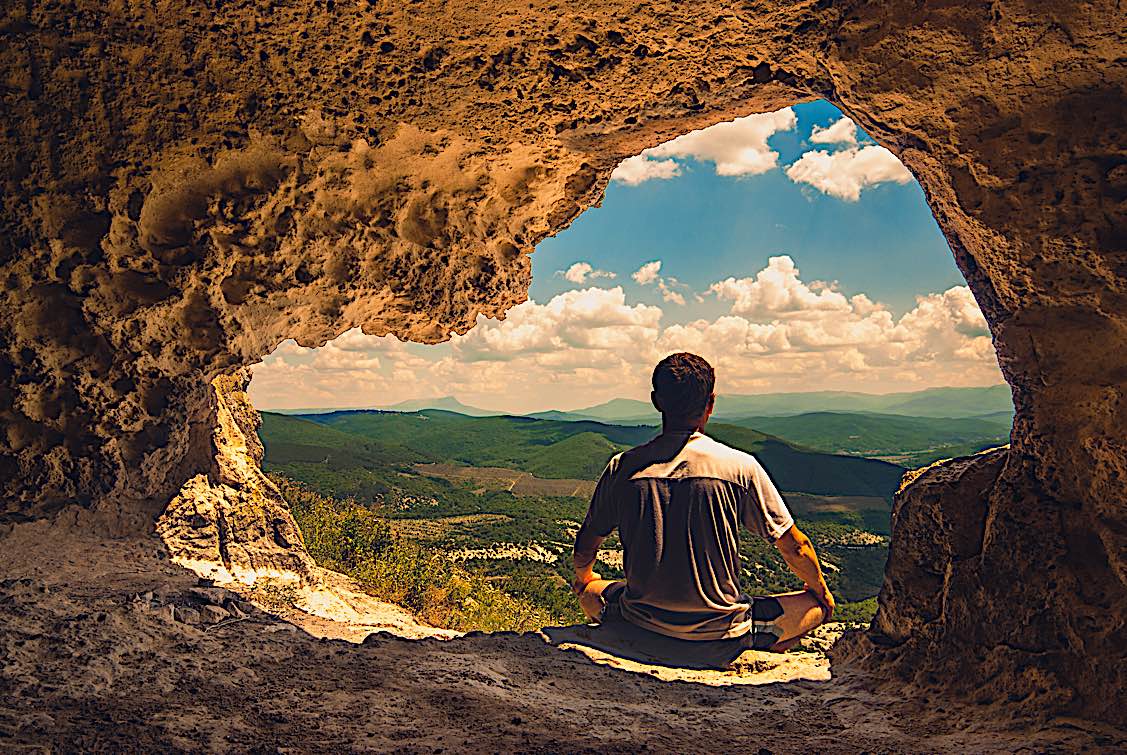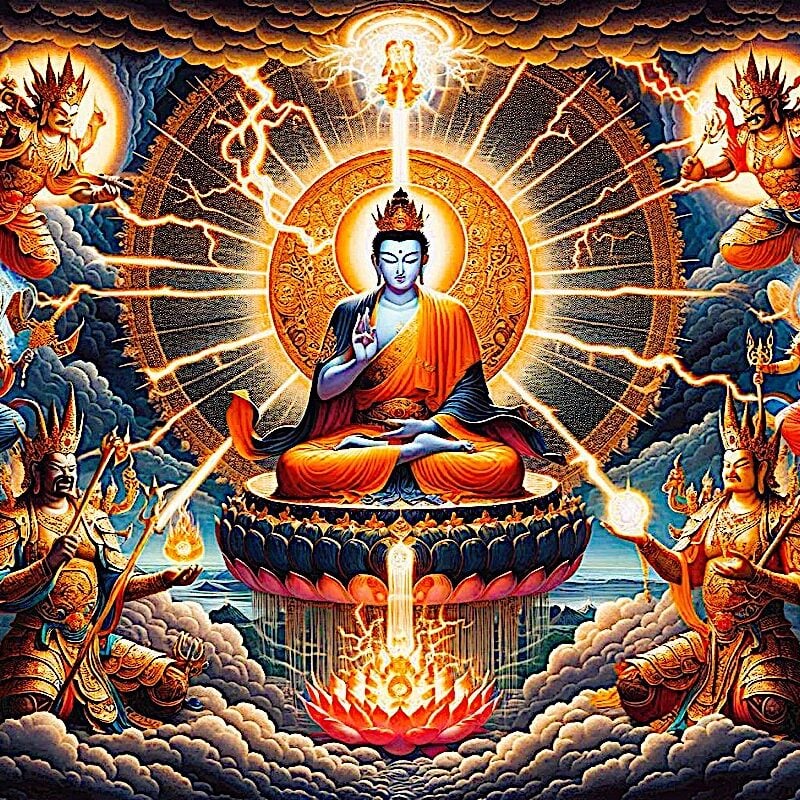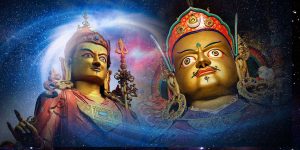Enlightenment in one lifetime? Guru Rinpoche Padmsambhava explains what it takes. Practice, discipline, and more practice!
What was Guru Rinpoche’s advice to his beloved consort disciple Lady Tsogyal on how to achieve enlightenment in this very lifetime? Seclusion, discipline, hard work, and the guru are among the most important. What advice would he have for us today, in this age of smart phones?
Padmasambhava, Guru Rinpoche, the Enlightened Padmakara, once taught Lady Tsogyal how to practice perfectly with self-discipline — basically, the message: I can’t do it for you. In the teaching, “The Crystal Garland of Faultless Practice”, the great and perfect Buddha taught the importance of overcoming laziness and “practicing incessantly” and — preferably — in seclusion during sessions.
“If you wish to attain enlightenment within one lifetime but do not enter the path of self-discipline, the practice will not be taken to heart. It is therefore essential to engage in self-discipline.” Guru Rinpoche [1]
The teaching to the Lady Tsogyal, delivered at the hermitage Pearl Crystal of Pamagong, also stressed the importance of meditations in seclusion — away from distractions. Today that would mean a closed door and a turned-off cell phone. A handy meditation cave would be nice, too.
Other features on Guru Rinpoche
- Special Feature: The Quantum Buddha Guru Rinpoche: the Second Buddha who turned the Vajrayana Wheel of Dharma: extensive commentary on mantras and practice
- Padmasambhava, the Lotus Born: “giving up idling and laziness” the importance of practicing incessantly and the path to self-discipline ; as recorded by Lady Tsogyal
- The tens of Padmasambhava: ten foundations of secret mantra; ten faults of being unsuccessful in Dharma practice; ten key points for practicing. Guru Rinpoche teaches Lady Tsogyal
- Padmasambhava Guru Rinpoche’s condensed “all teachings into one — which is concise and easy to practice”at the time of death: as requested by Lady Tsogyal
- Padmasambhava: The Eight Great Qualities of Taking Refuge; Taking Refuge in the Three Precious Jewels, the Defining Practice of Buddhism, and How it Can Rescue Us From All Dangers.

To begin the teaching — classically, the student always asks the teacher for the teaching — the Lady Tsogyal asked Guru Rinpoche: “How does one enter the path of self-discipline?”
No success for the lazy and pretentious
The great master replied, ” When first practicing the Dharma, if you do not practice with self-discipline but are indolent, lazy, and pretentious, you will have no success.” Among other things, he strongly discouraged the daytime nap: “Do not sleep during the daytime. This will bring numerous defects so give it up by all means.
“In general, if you desire happiness, carry through with your Dharma practice, undertaking self-discipline and accepting unpleasant conditions. Divide your days and nights into parts and practice in measured sessions. Your happiness will then be long-lasting. Keep that in mind!”
In answer to a follow up question from the Lady, he answers: “give up idling. Engage instead in Dharma activities such as making offerings to the master and the Precious Ones, making supplications and presenting tormas to the yidam, dakinis, and Dharma protectors.”
“No useless chatter”

In this day of social media, his advice to avoid “useless chatter” will likely not resonate, although clearly for someone in retreat it’s a must:
“Of all the distractions, the greatest is useless chatter. Consequently, unconnected empty talk is fatal to spiritual practice.”
Of course, in today’s culture, this would mean turning off the cell phone and computer when doing daily practice — even if you are not in retreat — and letting the family know not to disturb during your meditations.
Practice purification and offering “incessantly”
Even the most advanced of practitioners can never submit to laziness and give up the basics of daily purification and offerings. He advises:
“You should do what is called “taking Dharma activities as one’s path.” That is, you should transform into an unconditioned path the Dharma activities of meditation, making offerings, circum-ambulation, making tsa-tsa and tormas, reading aloud, chanting, copying texts, and so forth. Perform these activities incessantly. Through clinging, tiredness, and so forth, you do not accomplish the main objective.”
Importance of mantra recitation
When not in retreat, he stressed that during practice-time itself, silence from non-Dharma chatter is imperative, and advised the minimum sessions of mantra

recitations to keep uninterrupted from daily chatter: “When doing recitations, designate each of the three or four parts of the day a session, and vow to recite both day and night, at best one thousand, at the second best five hundred, or at least one hundred and eight recitations. Until completing that number, keep silence and do not interrupt your recitation with ordinary talk. In this way no obstacles will arise.”
Guru Rinpoche advises “do not allow your lips to be idle but continuously gather even single syllables of mantra. This is most important. Then at some point there will be accomplishment.”
If you do not have any other mantra, or as an appendix to your mantras, the great teacher recommends OM AH HUNG: “Of all types of recitation, recite the three syllables, OM AH HUNG, which are the essence of body, speech, and mind of all the sugatas. They are the most profound and all-inclusive. Therefore it brings great blessings to pledge to recite them or to append them at the head of all other mantra recitations.”

Bringing practice into daily life
To help avoid excuses, laziness and to further progress in understanding, Guru Rinpoche explains the importance of making daily life a Dharma activity:
“If you cannot mingle the Dharma with daily life activities, you will be fettered by the meditation session.”

When the Lady Tsogyal asked for clarity, he answered: “The dharmata devoid of constructs that you experience in your being while resting evenly in meditation should be put into practice in every situation during postmeditation; whether walking, moving around, lying down, or sitting. By never separating from this Dharma practice no matter what daily activity you perform, you will always remain in the state of dharmata. Thus your meditation will transcend sessions. In general, the meditator who imprisons his body and mind without applying the vital points of meditation is fettered by a chain. Keep that in mind!”
Importance of solitary time and retreat
To progress on the path, it is important to take some time for solitary retreat as well. Most Vajrayana teachers today advise at least one major retreat before we die, and ideally one retreat a year for serious practitioners — even if they are home retreats.
Guru Rinpoche explains, during retreat in particular: ” In general, much talk that is not Dharma practice or concerning Dharma is meaningless. There is no need for that. If you do not strive toward unexcelled enlightenment with your voice engaged in reciting and chanting after stopping ordinary talk, you are anyway like a mute. Keep that in mind!”
This is why, the master explained, the successful student who develops realizations seek out seclusion. For those who can, he recommends ” go to a retreat place such as a charnel ground, a highland area, a snow mountain, a remote hermitage, the dwelling place of a siddha, or a forest in auspicious months such as the seasons of summer and autumn, or on auspicious days such as the eighth day or the new and full moon days.”
He explains the normal methods of creating a retreat space, such as sweeping, making the seat, preparing a mandala and offerings and a shrine with “representations of enlightened body, speech and mind.” This is followed by preventing tormas.
“Giving up idling”
The point of retreat is, perhaps, more valid today than ever. In a private, alone-time retreat space, you give up the excuses to be lazy, to put off practice, and all the distractions of samsara.
“In the daytime you should train in regarding your perceptions as being dreams. That is to say, rest naturally and relaxed without correcting what appears. Leave your experience spontaneously free and open. Rest wide awake and without fixation. During evening time you should take awareness as the path. That is to say, heighten awareness at the close of day and rest alertly and wakefully without falling subject to drowsiness and stupor. At midnight mingle the state of deep sleep with dharmata and sleep in the state of nonthought. Apply the strong determination of thinking, I will recognize my dreams to be dreams! Through that you will be able to remember dharmata while dreaming and be liberated from elation or nightmare. At morning time you should take dharmata as path. That is to say, when you awake from sleep and your body feels at ease, bring dharmata to mind and practice this self-existing mindfulness without fixating, meditating, or slipping away into drowsiness. Do not give in to indulging in sloth and indolence, but practice wide awake while keeping the right measure of self-discipline.”
NOTES
[1] Padmasambhava Guru Rinpoche. Dakini Teachings (p. 138). Rangjung Yeshe Publications. Kindle Edition.
More articles by this author

Protection from all Harm, Natural Disaster, Weather, Spirits, Evil, Ghosts, Demons, Obstacles: Golden Light Sutra: Chapter 14

Guru Rinpoche is ready to answer and grant wishes: “Repeat this prayer continuously” for the granting of wishes

Buddhist body mandala practice in Vajrayana Buddhism — and riding the winds of the inner body “The prana goes where the mind goes.””
Search
Latest Features
Please support the "Spread the Dharma" mission as one of our heroic Dharma Supporting Members, or with a one-time donation.
Please Help Support the “Spread the Dharma” Mission!

Be a part of the noble mission as a supporting member or a patron, or a volunteer contributor of content.
The power of Dharma to help sentient beings, in part, lies in ensuring access to Buddha’s precious Dharma — the mission of Buddha Weekly. We can’t do it without you!
A non-profit association since 2007, Buddha Weekly published many feature articles, videos, and, podcasts. Please consider supporting the mission to preserve and “Spread the Dharma." Your support as either a patron or a supporting member helps defray the high costs of producing quality Dharma content. Thank you! Learn more here, or become one of our super karma heroes on Patreon.
Lee Kane
Author | Buddha Weekly
Lee Kane is the editor of Buddha Weekly, since 2007. His main focuses as a writer are mindfulness techniques, meditation, Dharma and Sutra commentaries, Buddhist practices, international perspectives and traditions, Vajrayana, Mahayana, Zen. He also covers various events.
Lee also contributes as a writer to various other online magazines and blogs.















